Can I Use The Same Microsoft Account On Two Computers Windows 10
Windows x and eleven tips
How to share a Windows 10 PC
Need to share a Windows 10 PC among employees or temporary workers at the office, or with family unit members at home? No problem — hither's how to do information technology.
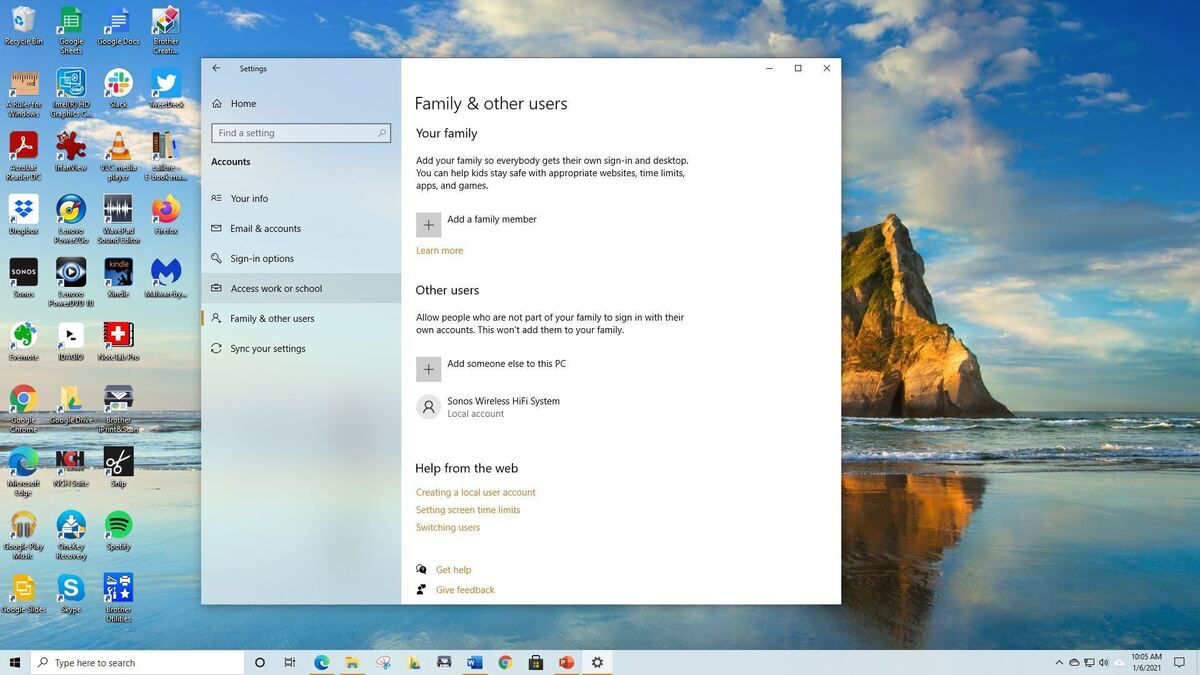
In some offices, computers are shared between two or more employees or temporary workers. That sounds similar a recipe for disaster, but Windows 10 has great tools for allowing multiple people to share a single PC without letting them read, edit, or delete each other's files and folders; use or delete each other'south applications; or brand system-wide customizations.
These tools tin also be a big assistance for people who work from home and need to share their PC with a family fellow member some of the time. They allow you to set and log in with dissimilar user profiles so each user has admission to only their ain files and folders, apps, and preferences. In this slice, I'll show you what to do.
This commodity has been updated for the Windows ten October 2020 Update (version 20H2). If y'all have an earlier release of Windows 10, some things may exist slightly different.
Setting up accounts for sharing a Windows 10 PC
Windows 10 makes it piece of cake for multiple people to share the same PC. To do information technology, y'all create separate accounts for each person who volition use the calculator. Each person gets their own storage, applications, desktops, settings, and and so on.
I person, the PC's administrator, sets up and manages all the accounts, including a multifariousness of system settings that just the ambassador can access. The administrator account is established when Windows is first installed or used on the machine. (You can as well upgrade other user accounts to administrator status, as I'll cover later in the story.)
If you're an administrator, setting up a user account is easy. First you'll need the electronic mail address of the person for whom you want to ready an account. Ideally, this should exist the sign-in information for their Microsoft business relationship (such equally an @outlook.com or @hotmail.com address or a corporate email address at an system that uses Outlook) so they'll be able to use all of their existing Windows settings, go access to their OneDrive storage, and download and install apps from the Microsoft Shop. Anybody tin sign up for a Microsoft account for free.
For at present, nosotros'll assume that the person you want to add has a Microsoft account. Later on I'll show you how to set up an account if they don't accept ane and don't want to register for one, but note that you can't ready restrictions for family members unless they sign in with a Microsoft account. Accounts for children tin only utilize an @outlook.com or @hotmail.com domain.
To add together a user, click the Start button, select Settings then choose Accounts. On the Accounts screen, cull Family & other users from the menu on the left. To set an business relationship for a co-worker, get to the "Other users" section and click Add someone else to this PC. To set up accounts for family members that let you set age limits, game and app restrictions, etc., instead choose Add a family member under the "Your family" section.
 IDG
IDG After you create an account for someone else, the name appears on the Accounts page. (Click any image in this story to enlarge it.)
On the screen that appears, enter the email accost of the person for whom you want to create a user account, click OK and then Stop. The user's proper noun now appears on the "Family & other users" accounts page.
It also appears when y'all click the icon representing the electric current user of the PC, midway down on the left side of the Start menu when you click the Commencement button.
 IDG
IDG When an account name is clicked in the First card, it will prove all of the accounts on the motorcar.
If y'all're the owner of the new account, there are 2 ways to showtime using it. You tin click the icon representing the account of the current user of the PC, midway down on the left side of the Commencement carte. That displays all the accounts on the PC. Click your account name and log into your business relationship with your Microsoft account password. Or you lot tin restart the PC: The Windows login screen will now have 2 accounts on it — yours and the administrator's. You can click your account name and log in with your Microsoft account password.
The account will have its ain separate OneDrive storage. Each user'southward local files and folders won't be accessible to the other. Y'all volition run across the Windows apps you've installed, but not anyone else's, and vice versa. Given that it's a Microsoft account, files and settings will sync with all other devices connected to your account.
Creating a new user business relationship without using a Microsoft account
Creating a shared PC if the other person doesn't have or want a Microsoft account takes a little fleck more work.
To practise it, become to Settings > Accounts > Family & other users > Add someone else to this PC. (This is same option you'll brand if you're adding a family member without a Microsoft account, but remember that you won't exist able to use parental controls.)
On the screen that appears, click I don't accept this person'due south sign-in data. Then at the bottom of the next screen, click Add a user without a Microsoft account.
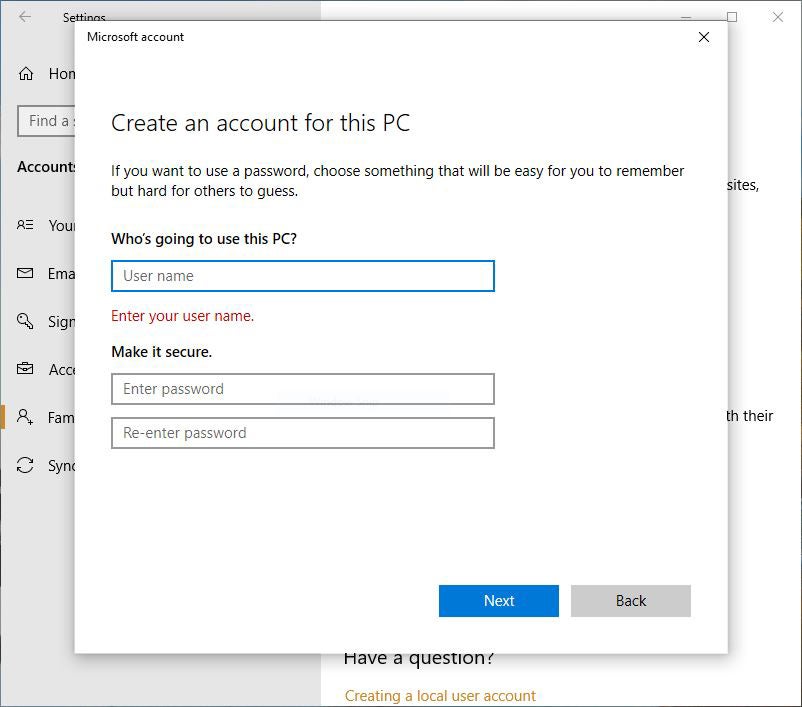 IDG
IDG Y'all tin can add together a user who doesn't take a Microsoft account as a local account.
Now you can add a user name and a password. The person'south account proper noun will now prove up the same way equally if you had created one using a Microsoft account.
When y'all create an business relationship for someone in this fashion, it'due south called a local account. Unlike a Microsoft account, information technology won't sync settings between devices, and it doesn't give access to OneDrive. In addition, when someone has a local account, they won't exist able to download or install any apps from the Microsoft Store. They won't be able to install desktop applications on their ain, either — when they try to install them, they're prompted for the password of the administrator'due south account. And then an administrator volition accept to exist nearby to type in the password in order for them to install desktop applications.
Switching betwixt accounts
Once your account has been gear up, it's like shooting fish in a barrel to switch from the account currently running on the auto to your own. If someone else is currently using Windows ten on the machine, and yous want to use it, you tin click the Start push button, click the icon representing the current user's business relationship midway down on the left side of the Commencement bill of fare, then click the account to which y'all want to switch and type in the password.
You tin can, of class, also log in from the lock screen, which displays all of the user accounts on the motorcar.
1 thing to proceed in heed when several people use a PC with separate accounts: Fifty-fifty when someone is not using the PC, they all the same remain signed into the account unless they sign out or the PC is restarted. And then several people might be signed into accounts, even though simply ane person is actively using the PC. (This does not mean that users have whatever access to the others' accounts. At that place can be only i agile account at a time; an individual user will still demand to re-enter the password to see their account.)
To see which users are currently signed in, click the Start button, and so click the icon representing the current user's business relationship midway down on the left side of the Start menu to meet all of the machine's accounts. Look underneath each business relationship. The words "Signed in" will announced under the advisable accounts.
What does it mean that someone is signed into their account, even if they're not currently using it? When someone is signed in, Windows 10 saves the state of that person'south user account — which applications the person was running, the files they were working on, and so on. That way, when they switches back to using their account, everything will be in identify, and they won't have to waste product time launching apps, opening files, and and then on.
This is useful, just it can be problematic too, considering information technology can atomic number 82 to lost work. When a PC is restarted or shut downward, all users on it are automatically logged off. Say someone is logged into their account and hasn't yet saved work — if the computer is switched to some other account, and the person using that second business relationship restarts or shuts down the system, the start person volition lose their unsaved work.
The result? It's always a adept idea to log out of your business relationship earlier letting someone else apply the same computer. It only takes a moment: Click your account name at the tiptop of the Beginning menu and and so click Sign out.
Managing accounts
If y'all desire to let some other user take administrator access, it's simple to exercise. Select Settings > Accounts > Family & other users, click the account to which you want to give administrator rights, click Change business relationship type, and then click Account blazon. Choose Administrator and click OK. That'll do it. You tin can always change it back to a standard user account later using this same method.
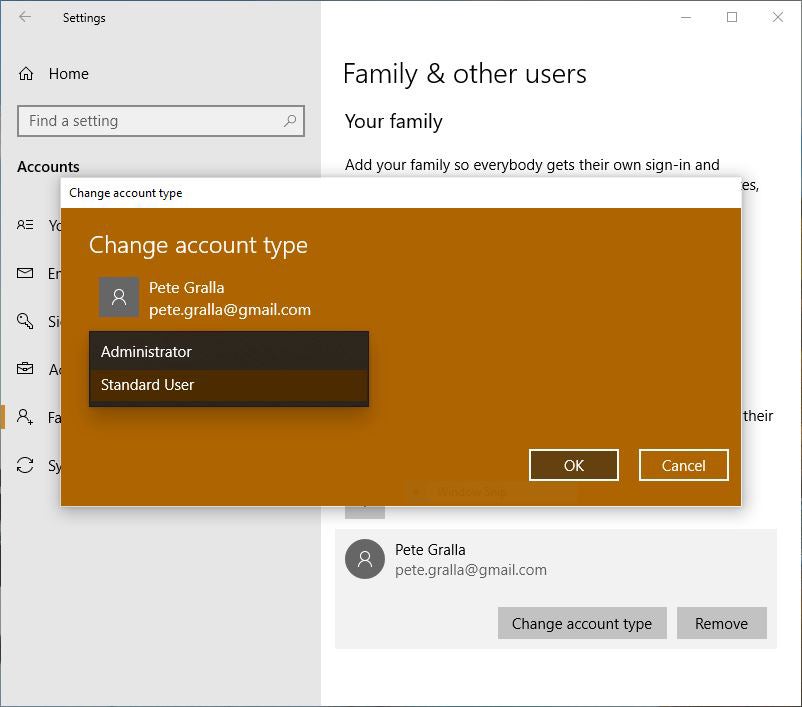 IDG
IDG You can modify a standard user account to an Administrator business relationship.
Information technology'due south also easy to remove accounts — as long equally you lot're the administrator. Select Settings > Accounts > Family & other users, click the account yous want to remove and then click Remove. A screen appears warning you lot that when you lot delete the account, y'all besides delete all information associated with it, which include files, desktop setup, apps, music then on. Likewise, note that you can only delete an business relationship if the person has signed out of Windows 10.
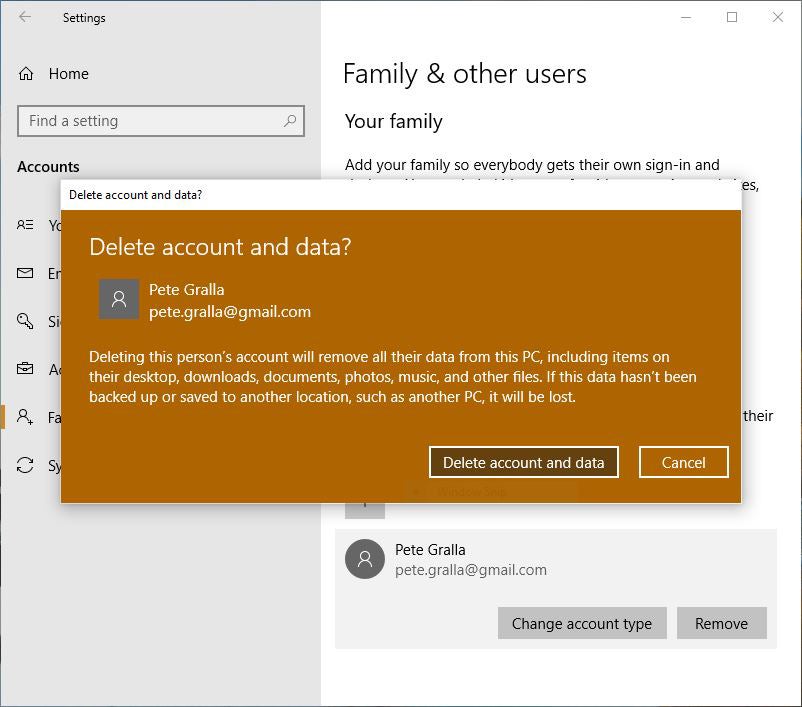 IDG
IDG When you delete an business relationship, you also delete all data associated with it.
Once you've got it in hand, y'all'll find that this is a simple and useful way for sharing a Windows 10 PC among multiple people.
Bonus tip: Plough on the hidden Windows 10 administrator account
I've got one more tip for you: how to turn on something that is sort of a super-administrator account hidden in Windows 10.
As I explained previously, the account y'all create when y'all install Windows is the PC'south ambassador account — it gives you command over how Windows 10 works on the PC, what other accounts can be created and so on. But Windows 10 likewise sets upward a hidden administrator account during installation.
This hidden account has 1 reward over a normal administrator account — when y'all utilise information technology, yous won't get whatsoever User Account Control (UAC) prompts. That makes it much easier to troubleshoot and customize Windows, because y'all won't be constantly bothered by those pesky UAC notices.
Some people refer to this hidden ambassador business relationship as an elevated account, and a normal one as an un-elevated business relationship.
It'south easy to turn on and use the hidden administrator business relationship:
- Make sure that you're using your normal Ambassador account.
- Click the First button, scroll downwardly through your apps and click Windows System.
- Right-click Command Prompt from the driblet-downwardly menu that appears, then click More and select Run as administrator. The control prompt launches. Await in the prompt's title bar — it will read "Administrator: Control Prompt."
- At the command prompt, type cyberspace user ambassador /active:yes and printing the Enter
That turns on the hidden administrator business relationship. It will appear on the Windows ten login screen and on the Start menu screen — only click it to employ information technology as you would any other account.
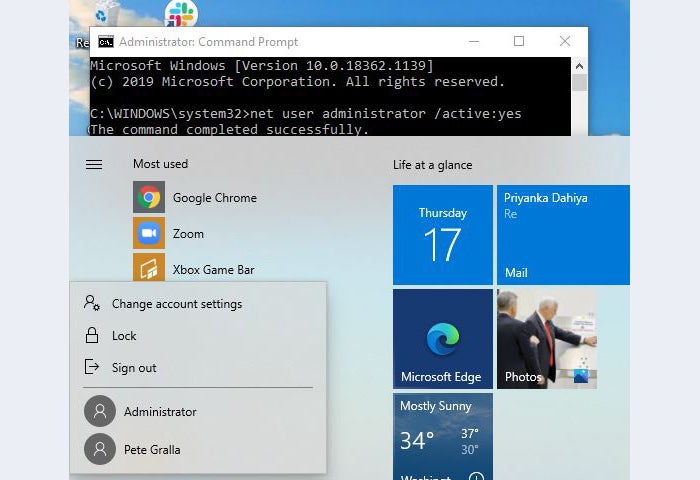 IDG
IDG When you plow on your PC's hidden administrator account, it shows up merely like whatsoever other account in Windows ten.
If yous want to disable the hidden account, follow steps i through three, and at the command prompt, type cyberspace user administrator /agile:no and press Enter.
This article was originally published in March 2016 and virtually recently updated in January 2021.
Copyright © 2021 IDG Communications, Inc.
Can I Use The Same Microsoft Account On Two Computers Windows 10,
Source: https://www.computerworld.com/article/3046707/how-to-share-a-windows-10-pc.html
Posted by: stewartneents.blogspot.com


0 Response to "Can I Use The Same Microsoft Account On Two Computers Windows 10"
Post a Comment